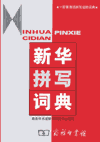
Here’s the first of several selected readings from Yin Binyong’s Xīnhuá Pīnxiě Cídiǎn (《新华拼写词典》 / 《新華拼寫詞典》). It covers the writing of verbs.
This reading is available in two versions:
For those who would like to read about this in English, see


Here’s the first of several selected readings from Yin Binyong’s Xīnhuá Pīnxiě Cídiǎn (《新华拼写词典》 / 《新華拼寫詞典》). It covers the writing of verbs.
This reading is available in two versions:
For those who would like to read about this in English, see
David Moser’s essay Why Chinese Is So Damn Hard — which is one of the most popular readings here on Pinyin Info, with perhaps half a million page views to date (nothing to dǎ pēntì at!) — has been translated into Mandarin: Wèishénme Zhōngwén zhème TM nán? (为什么中文这么TM难?). (Gotta love the use of Roman letters there.)
Although the translation has been online for only 24 hours or so, it has already received more than 150 comments.
A suggestion for readers and translators looking for something similar: Moser’s Some Things Chinese Characters Can’t Do-Be-Do-Be-Do.
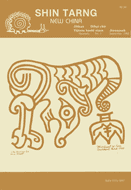 I’ve just put up another issue of Xin Tang.
I’ve just put up another issue of Xin Tang.
As you may have noticed already, the name on the cover is given not as Xin Tang but as Shin Tarng. That’s because the journal started out being published in the Gwoyeu Romatzyh romanization system. But using the Hanyu Pinyin spelling here helps me keep track of these better.
Almost all of this issue is in Mandarin written in Gwoyeu Romatzyh. One article also has an en face translation into English. And as is the case with the other issues of Xin Tang, a variety of topics are covered.
Shin Tarng no. 1 (September/Jiǔyuè 1982)
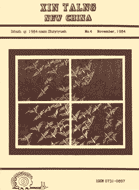 The fourth issue of Xin Tang is now online.
The fourth issue of Xin Tang is now online.
For those of you wondering why Xin Tang is spelled Xin Talng on the cover, that’s because parts of this particular issue use a tonal-spelling variation of Hanyu Pinyin, as follows.
Simple rules for tonal spelling
- ma (媽) / ling (拎)
- mal (麻) / lilng (零)
- maa (馬) / liing (領)
- mah (罵) / lihng (另)
- “‘” biaaoshih qingsheng, kee’shi “‘de” dou –> “d”.
Here, for example, is a message from the publisher.
Colng zheih yihqi qii SHIN TARNG gaai weil XIN TALNG, shiiyohng d welnzih yii Pin Yin (jiaan xiee PY) weil jichuu. Duobahn d welnzhang yohng yooudiaoh PY xiee. Biaodiaoh faa qiing kahn fengmiahn erh xiah’tou d jiaandan shuomilng.
The same passage in Pinyin with tone marks:
Cóng zhèi yì qī qǐ SHIN TARNG gǎi wéi XIN TANG, shǐyòng d wénzì yǐ Pīn Yīn (jiǎn xiě PY) wéi jīchǔ. Duōbàn d wénzhāng yòng yǒudiào PY xiě. Biāodiào fǎ qǐng kàn fēngmiàn èr xià’tou d jiǎndān shuōmíng.
Not all of the romanization in this issue follows that form. Some has no special spellings but instead uses tone marks. Some has no tone marks. Give ‘em all a try and see what you think.
Xin Tang 4 (PDF)
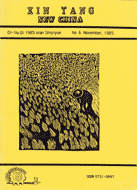 My previous post linked to a new HTML version of Homographobia, an essay by John DeFrancis. The work was first published in November 1985, in the sixth issue of Xin Tang (New China).
My previous post linked to a new HTML version of Homographobia, an essay by John DeFrancis. The work was first published in November 1985, in the sixth issue of Xin Tang (New China).
Xin Tang (Xīn Táng) is an especially interesting journal in that it is primarily in Mandarin written in romanization. A variety of romanization systems and methods are employed over the course of the journal. Indeed, over the course of its run one can see many questions of systems and orthographies being worked out.
I want to stress, though, that the journal does not restrict itself to material of interest only to romanization specialists. It also features poetry, illustrated stories, philosophy, letters to the editor, children’s material, and much more.
English and a few Chinese characters are also found; and there are even articles in languages such as Turkish (with Mandarin and English translations).
Most of what appears in English is also translated into Mandarin — romanized Mandarin, of course. So DeFrancis’s essay also appears, appropriately, in Pinyin:
Homographobia is a disorder characterized by an irrational fear of ambiguity when individual lexical items which are now distinguished graphically lose their distinctive features and become identical if written phonemically. The seriousness of the disorder appears to be in direct proportion to the increase in number of items with identical spelling that phonemic rendering might bring about….
Tongyinci-kongjuzheng shi yi zhong xinli shang d shichang, tezheng shi huluande haipa yong pinyin zhuanxie dangqing kao zixing fende hen qingchu d cir hui shiqu tamend bianbiexing. Kan qilai, zhei ge bing d yanzhongxing gen pinyin shuxie keneng zaocheng d tongxing pinshi shuliang d zengjia cheng zhengbi….
All of the issue with the DeFrancis essay is now online: Xin Tang no. 6.
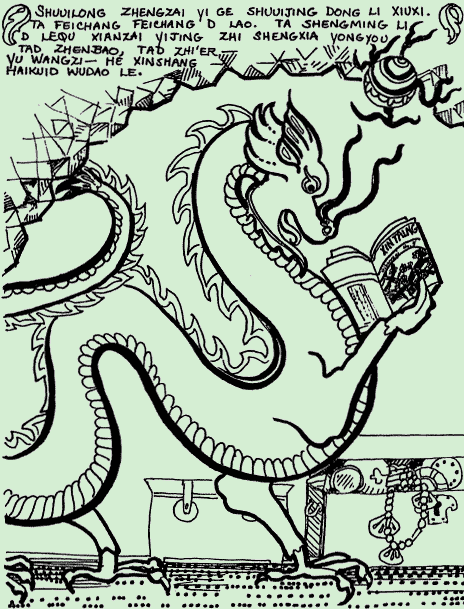
Note the occasional employment of a tonal spelling (shuui).
Maryknoll Language Service Center has put online the complete texts of its Taiwanese-English and English-Taiwanese dictionaries. Better still, these have been released under a Creative Commons license. These are a terrific resource for anyone who’s interested in Hoklo.
Maryknoll deserves praise for this great work. Thanks are due, too, to Tailingua, which I know has been working behind the scenes to help make this happen.
From the English Amoy Dictionary (英語閩南語字典):
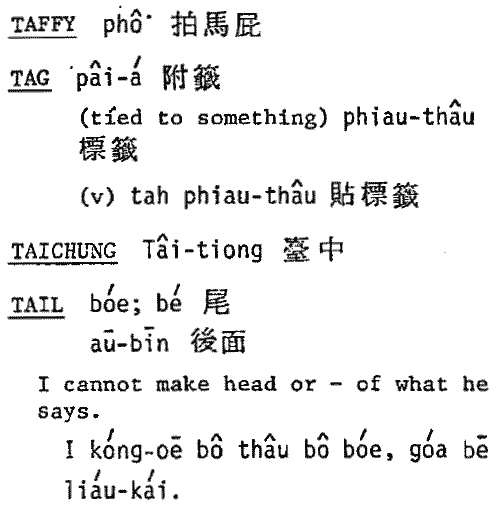
And from the Taiwanese-English Dictionary (台語英語字典):
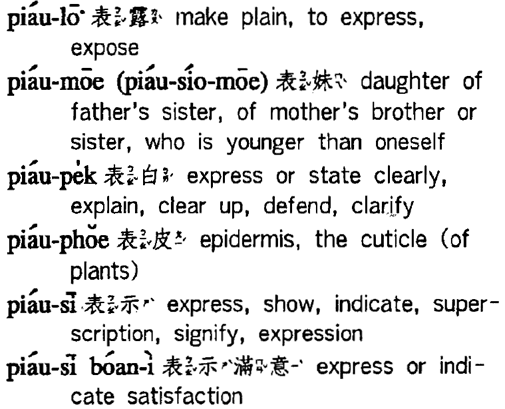
source: Maryknoll dictionaries now free to download, Tailingua, June 17, 2010
Mac users — especially those familiar with the old, non-Unicode TimesPinyin font — may want to look into Zev Handel’s TimesPinyin Keyboard Layout, which is designed to make typing Pinyin with tone marks easy.
It’s Unicode compliant, too.
Sino-Platonic Papers has rereleased for free its sixth volume of reviews, mainly of books about China and its history and languages (5.6 MB PDF).
The reviews are by David Utz, Xinru Liu, Taylor Carman, Bryan Van Nordan, and Victor H. Mair.
Contents
- Review Article by David A. Utz of Ádám Molnár, Weather-Magic in Inner Asia. With an Appendix, “Alttürkische fragmente über den Regenstein,” by P. Zieme. Indiana University Uralic and Altaic Series, 158. Bloomington, Indiana: Indiana University, 1994.
- Graham Parkes, ed., Heidegger and Asian Thought. Honolulu: University of Hawaii Press, 1987. Reviewed by Taylor Carman and Bryan Van Norden.
- Beijing Daxue Nanya Yanjiusuo [Peking University Institute for South Asian Studies], ed. Zhongguo zaiji zhong Nanya shiliao huibian (Collection of South Asian Historical Materials from Chinese Sources). 2 vols. Shanghai: Shanghai Guji Chubanshe, 1995. Reviewed by Xinru Liu.
The following 23 reviews are by the editor of Sino-Platonic Papers.
- Ronald E. Emmerick and Edwin G. Pulleyblank. A Chinese Text in Central Asian Brahmi Script: New Evidence for the Pronunciation of Late Middle Chinese and Khotanese. Serie Orientale Roma, LXIX. Rome: lstituto ltaliano per ii Medio ed Estremo Oriente, 1993.
- YIN Binyong and SU Peicheng, eds. Kexuede pingjia Hanyu hanzi [Scientifically Appraise Sinitic and Sinographs]. Zhongguo yuwen xiandaihua congshu (Chinese Language Modernization Series), 1. Peking: Huayu Jiaoxue Chubanshe (Sinolingua), 1994.
- WU Chang’an. Wenzi de toushi — Hanzi lunheng [A Perspective on Culture — Balanced Discussions on the Sinographs]. Wenhua Yuyanxue Congshu [Cultural Linguistics Series]. N.p. (Changchun?): Jilin Jiaoyu Chubanshe, 1995.
- ZHOU Shilie, comp. Tongxingci cidian [Dictionary of Homographs]. Peking: Zhongguo Guoji Guangbo Chubanshe, 1995. (Reviewed twice from different perspectives in the same issue.)
- KANG Yin. Wenzi Yuanliu Qianshi (The Origin and Development of Chinese Ideographs) (sic). N.p.: Guoji Wenhua Chubanshe, 1992.
- DUAN Kailian. Zhongguo minjian fangyan cidian [A Dictionary of Chinese Folk Topolecticisms]. Haikou: Nanhai chuban gongsi, 1994.
- CHANG Xizhen, comp. Beiping tuhua [Peking Colloquialisms]. Taipei: Shenge Shiye Youxian Gongsi Chubanshe, 1990.
- ZHANG Xunru. Beiping yinxi xiaoche bian [A Compilation of Words with “er” Suffix in Pekingese]. Taipei: Taiwan Kaiming, 1991; 2nd Taiwan ed.; 1956, first Taiwan ed.
- LI Sijing. Hanyu “er” [] yin shi yanjiu [Studies on the History of the “er” [] Sound in Sinitic]. Taipei: Taiwan Shangwu, 1994.
- Erdengtai, Wuyundalai, and Asalatu. Menggu mishi cihui xuanshi [Selected Explanations of Lexical Items in The Secret History of the Mongols]. Mengguzu lishi congshu [Series on the History of the Mongolian People]. Hohhot: Neimenggu Renrnin Chubanshe, 1980; 1991 rpt.
- Matthews, Stephen and Virginia Yip. Cantonese: A Comprehensive Grammar. Routledge Grammars. London and New York: Routledge, 1994.
- Killingley, Siew-Yue. Cantonese. Languages of the World / Materials 06. München-Newcastle: Lincom Europa, 1993.
- ZHONG Jingwen, chief ed. Yuhai (An Encyclopedia of Chinese Folk Language), Vol. 1: Mimiyu (Chinese Secret Language). Vol. editors ZHENG Shuoren and CHEN Qi. Shanghai: Shanghai Wenyi Chubanshe, 1994.
- Harrell, Stevan, ed. Cultural Encounters on China’s Ethnic Frontiers. Seattle and London: University of Washington Press, 1995.
- Woo, Henry K. H. The Making of a New Chinese Mind: Intellectuality and the Future of China. Hong Kong: China Foundation, 1993.
- Miller, Lucien, ed. South of the Clouds: Tales from Yunnan. Translated by GUO Xu, Lucien Miller, and XU Kun. Seattle and London: University of Washington Press, 1994.
- Hoizey, Dominique and Marie-Joseph Hoizey. A History of Chinese Medicine. Tr. by Paul Bailey. Vancouver: UBC Press; Edinburgh: Edinburgh University Press, 1993.
- Crystal, David. An Encyclopedic Dictionary of Language and Languages. London: Penguin, 1992, 1994.
- Day, Gordon M. Western Abenaki Dictionary. Vol. 1: Abenaki-English. Vol. 2: English-Abenaki. Mercury Series, Canadian Ethnology Service, Papers 128 and 129. Hull, Quebec: Canadian Museum of Civilization, 1994-95.
- Hassrick, Peter H. The Frederic Remington Studio. Cody, Wyoming: Buffalo Bill Historical Center, in association with University of Washington Press (Seattle, London), 1994.
- Jonaitis, Aldona, ed. Chiefly Feasts: The Enduring Kwakiutl Potlatch. Seattle and London: University of Washington Press; New York: American Museum of Natural History, 1991.
- Jerry L. Norman and W. South Coblin. “A New Approach to Chinese Historical Linguistics.” Journal of the American Oriental Society, 115.4 (1995),576-584.
Bits and Pieces
- Letter concerning An Zhimin’s views on the origins of bronze metallurgy in China.
- “Yet again on Tibet.” This is one in a continuing series of discussions with Edwin G. Pulleyblank, W. South Coblin, and others on the origins of the name “Tibet”.
This was first published in February 1996 as issue no. 70 of Sino-Platonic Papers.